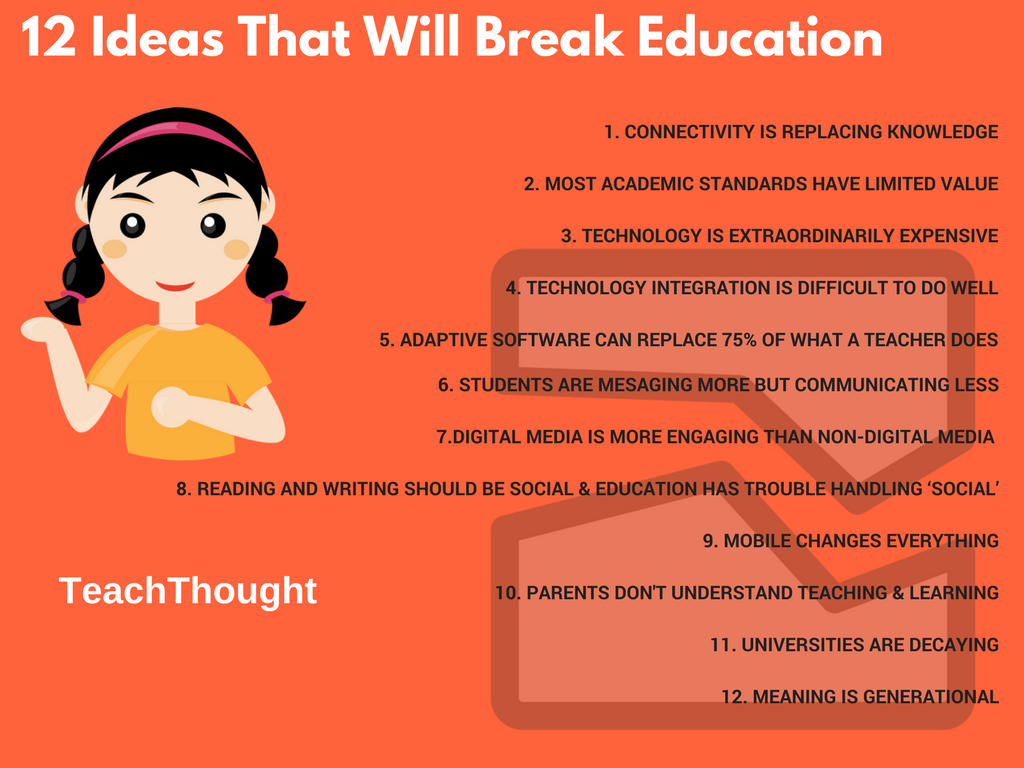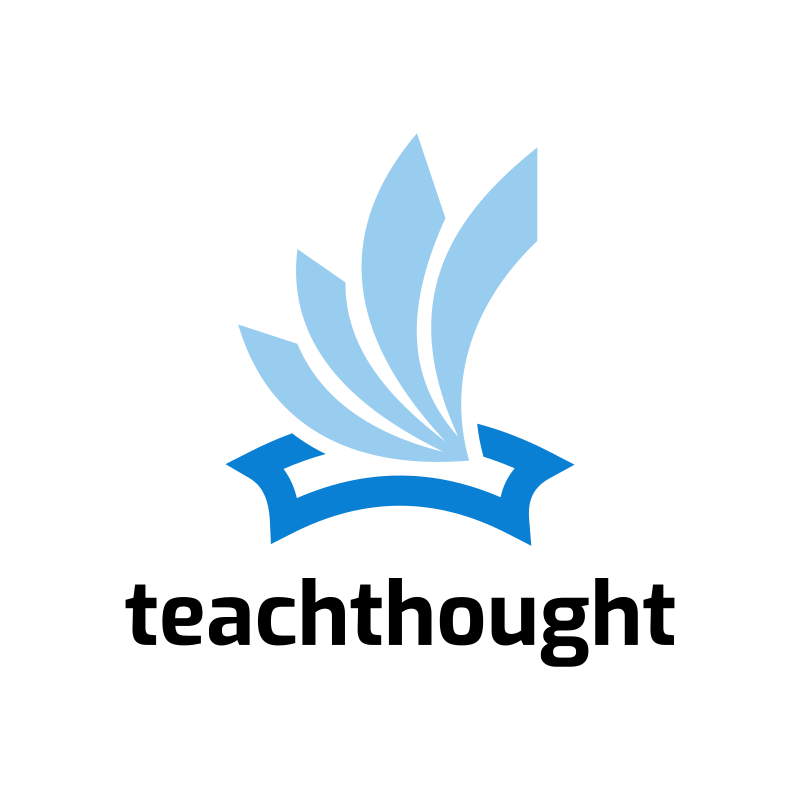
12 Ideas That Will Probably Break Education
by Terry Heick
As the education changes, it depends primarily on internal catalysts for that change.
That is, the ‘things’ that change it are on the ‘inside’ of that system itself, most notably data, assessment, PLCs, and running a distant fourth, technology. It’s interesting that technology is among the least impacting “agents of change” in the classroom. Certainly it has caused teachers and districts to update some of their practices (e.g., budgets, teacher training, and IT policies) but very little of their thinking (e.g., peer-to-peer and school-to-school collaboration, assessment forms, and learning models).
At some point, this will change. Eventually the tethers will break and education–in whatever form or forms–will shoot forward like it’s been held back in a slingshot for nearly a century. It may not feel triumphant at first. When things you lean on give way, you flail and panic and yelp.
There will probably be a lot of that. It may be messy, implementation dip and all. It will require innovation and perseverance. But if we are courageous enough to let these ideas ‘break’ education, we have the chance to come out on the other side evolved.
12 Difficult Realities That May Break Public Education As We Know It
1. Connectivity is replacing knowledge.
Or rather usurping it in terms of sheer credibility.
Businesses, the education institutes, groups, organizations, people—everyone wants visibility and access. These occur through connectivity. The ability to survey digital landscapes, identify trends, adapt language and rhetorical forms, experiment with the fluidity of media, and create ‘traction’ for products and ideas across dozens of social networks—these are powerful agents for disruption and change.
What do I know, and what should I do with what I know? How does always-on access to Google, digital communities, and vast multimedia libraries credit or discredit the idea of ‘knowing’ something? How are we connected to one another? How does technology enhance and limit those relationships?
How can I use those things I am connected to and with to live the kind of life I want to live? Now replace ‘the things I am connected to and with’ with the word ‘my education’ and read it again.
Knowledge will always matter, but in an economic sense of supply and demand, information is boundless. It’s authentic feedback loops and resultant behavior modification that are now scarce.
2. Most academic standards have limited value.
It doesn’t mean they’re not worth knowing, but the mix of academic skills and understandings collectively represent an index of academic priorities that don’t directly speak to the human experience or the ability to live a meaningful life.
And that’s a problem.
3. Technology is extraordinarily expensive.
From the initial cost of purchase, to the cost of training and ongoing prof professional development to long-term cost of obsolescence, technology is expensive enough to sink even the largest, most successful business if not integrated properly. For thousands of schools across dozens of states, the cost could reach into the billions.
4. Technology integration is difficult to do well.
Effective technology integration in the classroom is difficult. To accomplish it on a daily basis—and do so well enough to justify the enormous cost referenced above? Even more of a challenge.
Get it wrong and money is wasted, teachers leave the profession in droves, and student learning slows or becomes even less authentic and more ‘like school’ because keeping pace with the real world just isn’t sustainable.
When this happens year after year after year, generation after generation, eventually school discredits itself and forced new solutions to learning to emerge.
5. Adaptive software can replace 75% of what a teacher does.
No, apps can’t replace teachers, but in terms of the way teachers spend their time, adaptive software—whether minor or major in scale—can automate the bulk of these tasks. Ideally, this would free teachers for more human and emotionally complex interactions, provided strategic adjustments are made.
6. Students are messaging more but communicating less.
That is, they’re writing more but saying less.
7. Digital media is more engaging than non-digital media.
Whether because of social elements, gamification, curation possibilities, or the lights, colors, and sounds, digital media has the attention of our children.
Think about YouTube. YouTube is packaged for consumption. It’s visual, social, diverse, mobile, and ‘chunked’ in ways that promote (often reckless) consumption. Always-on learning must compete with this—which means reading and writing must compete with this as well. This doesn’t mean books and essays aren’t useful, but rather that they exist in a new and dynamic context. Do we understand that context?
What is the relationship between Walt Whitman and poetry and race and bullying and texting and smartphones? There is one; it’s on you and I as educators to find it.
8. Reading and writing should be social, and the education has trouble handling ‘social.’
This doesn’t mean they always have to be social, but they need that potential built-in from the ground up. Instagram comments and eReaders with annotations is about as close as we’ve gotten to social reading and writing, while we’ve got dozens of ways for people to send one another minor little episodes of text, images, and video.
The next step is to leverage the social to create sustained opportunities for reading and writing.
9. Mobile changes everything.
That is, mobile technology will eventually change everything we do as a culture. It’s not going to stop at shopping, communication, and entertainment.
Not sure why this one isn’t agitating our thinking more. Companies like Microsoft, Apple, Google, Honda, Amazon, and well just about every other forward thinking company on earth are scrambling to adjust for a mobile culture that is cloud-based and social.
This should affect everything in the education, from how learning models and curriculum are designed, to how students interact with one another and their local communities.
10. Parents don’t understand teaching and learning.
Parents speak in the language of terms and compliance because that’s how we speak to them.
They understand grades, behavior, some of the fundamentals of literacy, and other abstractions like effort, inspiration, success, and failure.
But what if they understood how people learn even half as well as most teachers? What if they understood the pros and cons of certain assessment forms (this isn’t rocket science), the inherent limitations of letter grades (there’s no way they don’t already have an instinct for this), or how to coach critical thinking and observation on a daily basis?
Parents are the sleeping giants in the education. Think of them as students with 25 years of life experience–and reality–tacked on. If they had any clue how poorly education serves most students (no matter how ‘successfully’ the student navigates the education in its current form), they might redirect anger currently pointed at teachers and principals, and point it instead at policymakers, and perhaps even take up the task themselves as entrepreneurs.
11. Universities are decaying.
And they’re exorbitantly expensive.
Without quick thinking and rapid adaptation, only the most prestigious universities will survive into the next century—likely as cultural relics and niche training and certification institutes (medical school, law school, etc.) They simply cannot survive as they now exist—an awkward kind of hybrid of career prep and highbrow intellectualism.
As they are, many universities (and those that fund and/or benefit from them) are racing to justify themselves instead of serve the people that depend on them, which is horrifying. Lowering the cost of college would help solve some of these issues but nowhere close to enough to justify to emerging and future generations who may not believe in it as a financial investment, much less one social and intellectual.
12. Meaning is sociallly constructed and thus ‘generational.’
Gender. Language. Equity. Race. Success. Sexuality. Community. Religion. Citizenship. Job. Literacy. These ideas are at the core of what it means to be a human being, and the meaning of each seems to shift some every generation, giving the education a bit of a moving target to hit.
Get this one wrong and the word ‘school’ doesn’t mean much of anything at all.
13. Increasingly, (some) students have alternatives to school.
There are new options for learning, and the most innovative don’t have the word ‘school’ in them. Charter schools and eLearning have been about as brazen as the education can bring itself to be. But to appeal to the children of millenials—and their children and so on–they will have to compete with other possibilities that are frankly more compelling, creative, and social than marching through indexed curriculum.
How should schools and eLearning work together? What is the relationship between Google and a test? An app and a textbook? Mobile Learning and standardized assessment?
Equity continues to be a major challenge, as does the credibility of formal learning in general. As new options emerge, how can–and should–formal public education respond?
Disrupting Education: 12 Ideas That Will Permanently Break Education As We Know It
